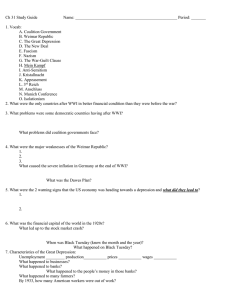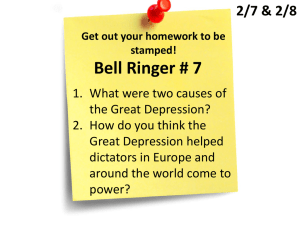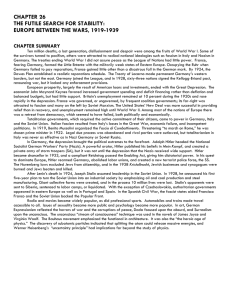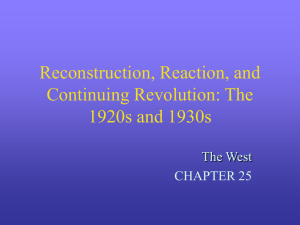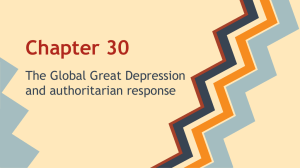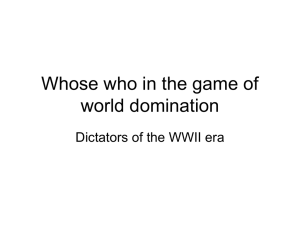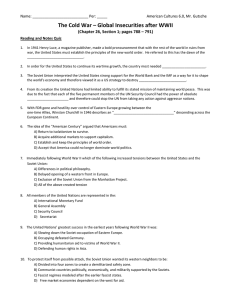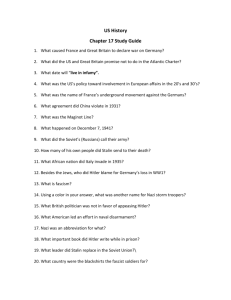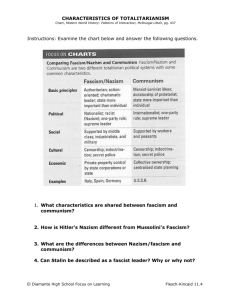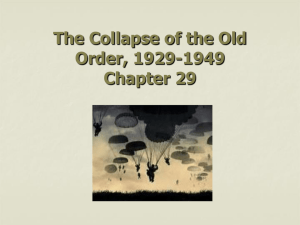Between the Wars: – Roaring Twenties & Revolutions 1920s
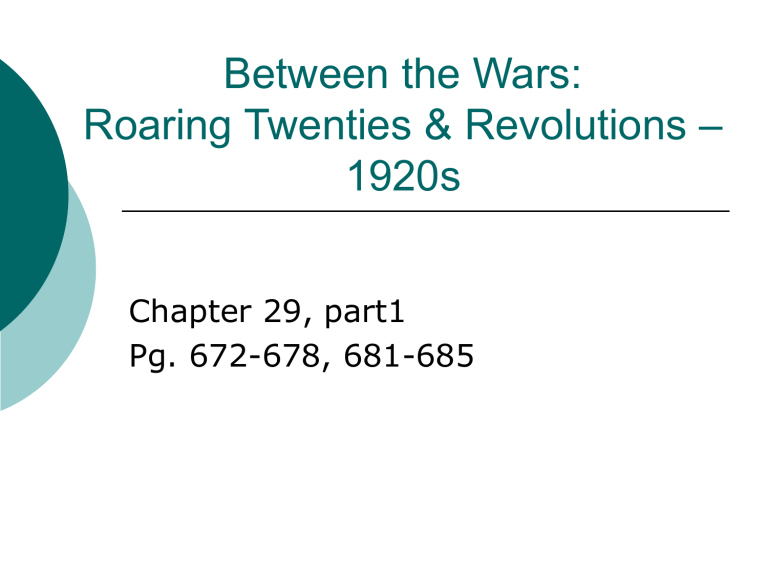
Between the Wars:
Roaring Twenties & Revolutions –
1920s
Chapter 29, part1
Pg. 672-678, 681-685
Bouncing Back?
Superficial prosperity marked mid-1920s
Modernity → Fine art; Pop culture
Women gained right to vote!
Alarming exceptions amidst frenzy
Lasting economic weakness remains in
Western Europe
Political extremism increases
Other Industrial Centers
Some prewar trends continue in white dominions & U.S.
Dominions: independence, economic & population growth
U.S.: expansion of economic & cultural influence – BUT diplomatic isolationism
Rise of Fascism - Italy
Ineffective liberal democracy & social unrest create atmosphere requiring conservative response for unity
Fascism & Mussolini created new Italian government
National identity promoted over individual
Corporate state w/ economic control
New Nations of Eastern Europe
Turn to authoritarian gov in response to nationalist excitement, territorial rivalry, & economies based on aristocratic export ag
EX- Yugoslavia, Poland, Latvia, Lithuania
1 of 3
Revolution in Russia
Poor social conditions & political ineffectiveness led to strikes, riots, & eventually overthrowing tsarist rule
Western reforms & liberal democracy doomed to fail
Weak liberal tradition, middle-class, & public support
Lenin & Bolshevik’s grab power & establish communist state
Soviet Union (USSR) is born
2 of 3
Revolution in Russia
Communists initially faced 2 major problems despite soviet support
Humiliating treaty ending WWI
Lack of broad support
Foreign hostility; Domestic resistance to loss of property, industrial nationalization, famine
Stability achieved through institutions
Red Army
New Economic Policy
Supreme Soviet
3 of 3
Revolution in Russia
Ultimately, revolution of great success that kept some tsarist traditions, but propelled new group to power
Societal change: education based on literacy, science & communism
Stalin succeeds Lenin with pragmatic, nationalistic brand of socialism
Sped industrialization & collectivization
Between the Wars:
Depression & Authoritarianism –
1930s
Chapter 29, part2
Pg. 690-694, 699-703
Causes & Debacle of Economic Depression
Stock market surge (based on loans)
Post-War
Inflation
(illusion of prosperity)
Competition
& Rising
Efficiency
Overproduction
Bank failures
& dried up
Investment
1929 stock market crash
Lost
Confidence
Reduced prices & profits
Production slows
Rising unemployment
Economic collapse
Shattered social & political ideals
Economic Responses in Europe & U.S.
W. Euro gov’ts responded ineffectively
High tariffs & spending cuts further slow economies
Inspired political polarization or overthrow
EX – Popular Front
Scandinavia, the exception, increased spending which created a welfare state
U.S. initially duplicated European mistakes, but New Deal takes
Scandinavian approach by increasing spending & reforming banking
Restored faith in gov, preventing extreme political change
Germany – Nazi Political Response
Depression & Treaty of Versailles make fascism a clear choice
Fascist, totalitarian gov, led by Hitler, quickly crafted
Emphasized unity, strong leadership & military, economic planning
Used personal hatred of Jews to create scapegoat for all Germany’s ills
Hitler speech before
Reichstag (July 13,
1934) addressing his elimination of political opponents.
"I gave the order to shoot those who were the ringleaders in this treason, and I further gave the order to burn down to the raw flesh the ulcers of this poisoning of the wells in our domestic life. …I am ready to undertake the responsibility at the bar of history for … the dearest thing that has been given us in this world--the German people and the German
Reich!"
Europe – Fascism Spreads in Response
Hitler’s success led to spread of fascist ideas in E. Europe
Hungary, Romania
Spain experiences civil war as result of liberal feuds w/ authoritarian supporters
Not fully fascist, but new authoritarian gov takes root advancing conservatism
W. Euro & U.S. respond weakly, fearing another war & distracted by depression
Soviet Union - Stalinism
Buffered from depression effects by separate communist economy
Collectivization (collective farms)
+’s: share expensive machines, controlled peasants & free labor for industry
-’s: messy transition = famine, central planning w/ little incentives
Industrialization (major goal)
Overwhelming success
Five-year plans
Soviet Union - Stalinism
Industrialization met w/ incentives, welfare services, & problem-solving
Stalin exerted total control
Controlled arts & sciences
Used secret police & party purges ruthlessly
USSR gradually shift from inward focus to more active diplomacy
